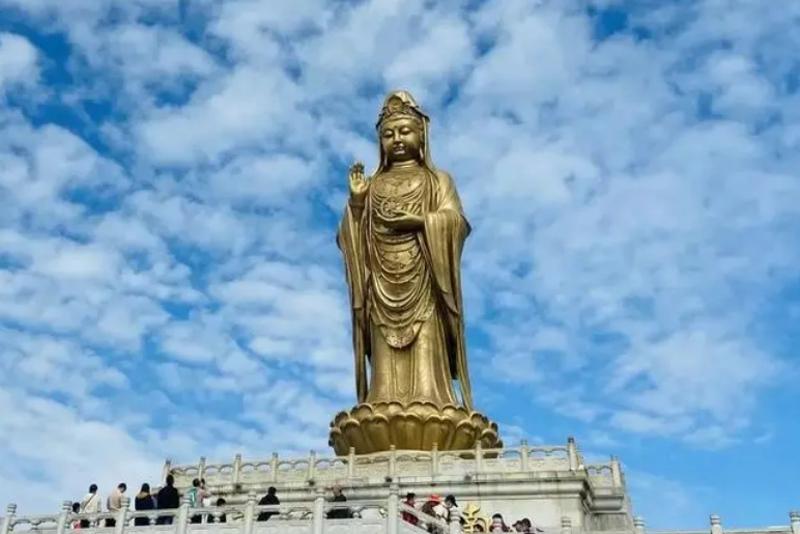Guanyin in the South China Sea

I. Introduction to Putuoshan
Geographic Location: Putuoshan is located in Zhoushan City, Zhejiang Province, China. It is the only mountainous island in the Zhoushan archipelago and is known as the "Sea and Sky Buddhist Kingdom" and the "Sacred Realm of the South Sea."
- It is approximately 250 kilometers from Shanghai and 100 kilometers from Ningbo.
- The island covers an area of approximately 12.5 square kilometers, with its highest peak, Mount Foding, reaching 288 meters above sea level.
Historical Development: Putuoshan has a long history of Buddhism, dating back to the Tang Dynasty. It boasts a profound Buddhist culture.
- During the Tang Dynasty, the Japanese monk Huie carried a Guanyin statue on his journey eastward. Due to stormy seas, the statue drifted to Putuoshan, and the Puji Temple was built there, marking the origin of Buddhism on Putuoshan.
- In the Song Dynasty, Putuoshan became one of the four famous Buddhist mountains in China, attracting numerous monks and devotees to come and pay homage.
- During the Ming and Qing dynasties, Buddhism on Putuoshan reached its peak, with numerous temples and flourishing incense offerings.
Natural Landscape: Putuoshan is renowned for its unique natural scenery.
- The mountains and sea intertwine, creating picturesque landscapes. The island boasts rich vegetation and rare animals, such as Putuoshan hornbeam and Putuoshan lily.
- Coastal erosion landforms are well-developed, with many unique rock formations, such as the "Unwilling to Leave Guanyin" and "Sunrise Cave."
- The sparkling blue waters and pleasing views make it an ideal location for admiring sunrises, sunsets, and seascapes.
II. The Origins and Legends of the South Sea Guanyin
The Origins of Guanyin Bodhisattva: Guanyin Bodhisattva is the embodiment of compassion and wisdom in Buddhism. Her image originated in India and spread widely throughout China.
- Guanyin Bodhisattva's Sanskrit name is Avalokiteshvara, meaning "the one who observes the sounds of the world."
- In Buddhism, Guanyin Bodhisattva represents the spirit of compassionate salvation, having achieved a high level of spiritual cultivation and capable of rescuing beings from suffering.
Putuoshan and the South Sea Guanyin: Putuoshan is regarded as the spiritual abode of Guanyin Bodhisattva, a place where she manifests her divine presence.
- The sacred image of Guanyin Bodhisattva is enshrined on Putuoshan, forming the most important center of faith on the island.
- There are numerous stories about Guanyin Bodhisattva manifesting her presence on Putuoshan. Folk legends include tales of "Guanyin Granting Children" and "Guanyin Saving People from Danger." These stories are widely circulated and deeply revered by the people.
- The image of Guanyin Bodhisattva has profoundly influenced the Buddhist culture of Putuoshan, making it the center of devotion to Guanyin Bodhisattva.
III. The Architecture and Art of the South Sea Guanyin
Puji Temple: The largest temple on Putuoshan, it was built in the Tang Dynasty and is the main temple for worshipping Guanyin Bodhisattva.
- It is grand in scale, with magnificent halls and numerous valuable relics and artworks.
- The temple houses the South Sea Guanyin statue, one of the most significant Buddhist images on Putuoshan.
Fayu Temple: The second largest temple on Putuoshan, it is known for its exquisite architecture and sculptures.
- It houses the statue of "Unwilling to Leave Guanyin," said to be the form of Guanyin Bodhisattva manifesting to help fishermen.
Guanyin Statues on Putuoshan: Putuoshan has various Guanyin statues, with the South Sea Guanyin statue being the most famous.
- The Sea Guanyin Statue: Standing 33 meters tall on the coast of Putuoshan, it is one of the most important landmarks of the island.
- The Guanyin statue enshrined in Puji Temple: 19 meters tall, it is one of the oldest Guanyin statues on Putuoshan.
Putuoshan Buddhist Art: Buddhist art on Putuoshan is diverse, reflecting the essence of Buddhist culture and the faith in Guanyin Bodhisattva.
- The statue sculptures are exquisite and unique in style, demonstrating the highest level of Chinese Buddhist art.
- Religious paintings, calligraphy, music, and other art forms are also abundant, showcasing the charm of Putuoshan Buddhist culture.
IV. Putuoshan and the Guanyin Faith
The Connection between Putuoshan and the Guanyin Faith: As the spiritual abode of Guanyin Bodhisattva, Putuoshan is the center of the Guanyin faith.
- Every year, devotees from around the world come to pay homage to Guanyin Bodhisattva, seeking peace and happiness.
- The Guanyin faith on Putuoshan has also influenced the culture and customs of surrounding areas, becoming an important cultural heritage of China.
The Significance of the Guanyin Faith: The Guanyin faith reflects the Chinese people's pursuit of compassion, kindness, and wisdom.
- The image and stories of Guanyin Bodhisattva inspire people to seek inner peace and spiritual elevation.
- The Guanyin faith also promotes social harmony and moral development, providing spiritual solace and moral guidance for people.
V. Conclusion
As one of the four famous Buddhist mountains in China, Putuoshan attracts countless tourists and devotees with its unique natural landscape and profound Buddhist culture. The South Sea Guanyin, as a symbol of Putuoshan, represents the spirit of compassion, wisdom, and salvation, bringing spiritual comfort and a sense of belonging to people. The Buddhist culture of Putuoshan is not only an important cultural heritage of the Chinese nation but also a treasure in the world's cultural heritage.